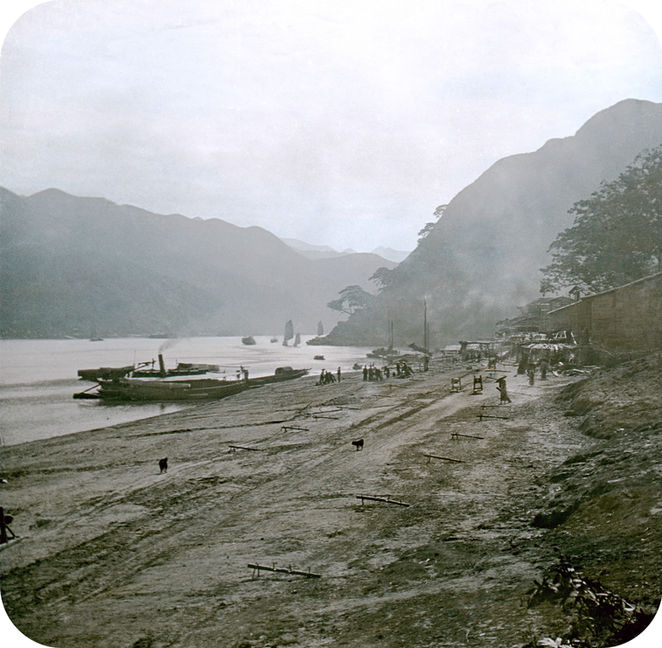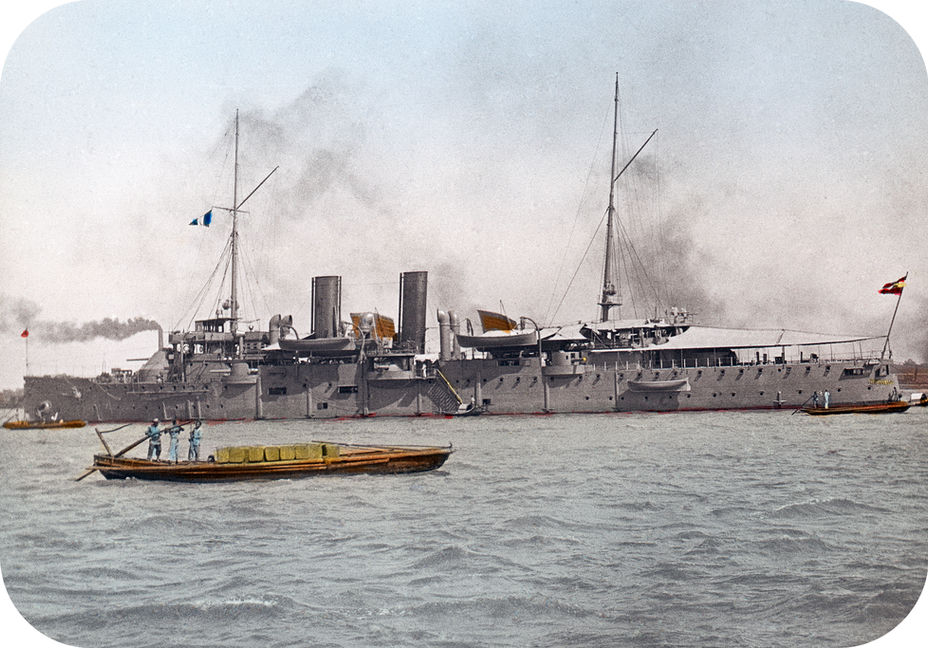
THE CITY OF FLOWERS
Dezső Bozóky’s Canton Photographs
As a naval officer with the Austro-Hungarian Navy, Dezső Bozóky first left Hong Kong for Canton before travelling to Fujian province, Shanghai and Beijing, where he documented the countryside
and cities as well as their inhabitants. His interest in nature and architecture and, above all, the Qing dynasty street scenes
and people he met, continue to transmit the excitement
and wonder of this early European traveler in a country
and culture far from his own.
Following the University Museum and Art Gallery’s 2016 exhibition of Dezső Bozóky’s photographs of Hong Kong—Two Years in Asia: Travelling in Hong Kong 1907–1909—the Museum was honoured
to present a larger group of Bozóky’s images that document
his time exploring other provinces across the Middle Kingdom.

Along China’s Coast: Dezső Bozóky’s Travel Photography 1908–1909 was exhibited at UMAG from 8 November 2019 to 9 February 2020. Both of these exhibitions and associated publications were made possible thanks to the collaboration and generous support of the Ferenc Hopp Museum of Asiatic Arts in Budapest and the Hungarian Consulate General in Hong Kong and Macau.
from the Canton Diary
of Dr Dezső Bozóky
“During my time in China one of the most fascinating
journeys was undoubtedly the three weeks that I spent in Canton.
There is no other city in the vast Empire of Heaven quite
as fascinating. Here, one is able to experience how the Chinese
truly live! Although the New Year’s festivities had already
finished in Hong Kong, every store in Canton was still closed,
for the locals maintain the tradition of spending the entire
three weeks celebrating the only official holiday on the
Chinese calendar. Since the celebration had altered the everyday character of the city, I considered this an opportune time
to embark on a three-day excursion up the Pearl River,
along one of its tributaries known as the West River.
To this day, the excursion remains one of my fondest memories.”
“WHEN I WENT UP ON DECK THE NEXT MORNING, I CAUGHT MY FIRST GLIMPSE OF THE WHITE STEAMBOAT ANCHORED CLOSE BY, PUFFING AWAY MERRILY WITH A FRENCH FLAG AT ITS STERN.
The crew and supplies were already on board;
we only needed to haul over our bedclothes,
blankets and toiletries, and then the craft would be
on its way to the town of Sam-Shui, beneath whose walls it would await us the next morning. From there we intended to travel by train. The boat required
an entire day from Canton, following the river’s serpentine twists and turns.”


“WE WATCHED THE MOST INTERESTING TYPES OF WATER CRAFT. LONG, NARROW SAMPANS PASSED BY NEARLY WEIGHED DOWN TO THE POINT OF SINKING WITH FIREWOOD OR SACKS, WHILE ON THE OUTSIDE, UNABLE TO FIT INSIDE, HUNG SEVERAL FISH, EACH A METRE AND A HALF IN LENGTH.

The river is so wide in some places one can hardly see both banks.Seated behind one another in pairs, in the long bow of the sampans, is a suntanned rowing crew, usually twelve people all wearing large hats. Paddleboats of labourers head downstream, while along the riverbank, more labourers drag a large junk upstream, against the current, bent over as they heave the rope tied to its mast.”

Slender, staggered pagodas dot the mountains, with small towns and villages beneath. Onlypagodas and towering, windowless strongholds rise over the grey roof tiles. At around four in the afternoon we docked in front of the noble grey walls of the city of Shui-Hin. It is almost completely overgrown with grass and bushes, and its crumbling, tall pagoda is beautifully reflected in the smooth surface of the river.”
“THE ENORMOUS RIVER SUDDENLY NARROWED, LIKE THE KAZAN GORGE ON THE DANUBE. THE RUSHING CURRENT
IS CONSTRAINED BETWEEN WILD CLIFFS STRETCHING UP TO THE SKY.

“We climbed to the top of one of
the hills for a panoramic view of
the endless rice fields, crossed by
a web of winding embankments topped with an uninterrupted stream of people moving like a brightly coloured serpent. On my shoulder
I carried my camera, fixed to its tripod, ready to shoot; but no matter how quickly I set it up, the pretty Chinese girls and women were always a step quicker, leaping
from the lens, or at least covering their faces with silk scarves,
which resulted in me achieving
little with my photography.”


“IT WAS WONDERFUL THE NEXT MORNING UP
ON DECK, HAVING A GOOD WASH IN THE FRESH MORNING AIR. THE CHINESE, OF COURSE, HAD NO COMPREHENSION OF WHAT A MAGNIFICENT
LUXURY THIS IS.UP ABOVE WAS COMPLETELY
CLEAR AND THE SUN SHONE DOWN WARMLY
FROM A CLOUDLESS BLUE SKY. AFTER A HEARTY BREAKFAST, WE SET OFF IN A JOLLY MOOD ALONG
THE EMBANKMENT THAT LINED THE RIVER, IN THE SHADE OF SLENDER PALMS AND ENORMOUS
BANYAN TREES, BEFORE TAKING A LEFT TURN AND PROCEEDING UPSTREAM BY THE SIDE OF A BROOK.

The beautiful sights along our route
were endlessly varied and breathtaking. In the greenish semi-darkness of the forest, pavilions with crooked roofs stood alongside the path, decorated
with fantastical Chinese characters. Without making a sound, as though walking upon a deep Persian carpet,
we climbed up the moss-covered steps
to the great waterfall; its roar could
be heard from afar.”


“Our ship reached the mouth of the Pearl River Delta,
the ‘Bocca Tigris’. From the hills on both shores, enormous
Krupp cannons stared down from their Chinese fortifications.
After passing between the bizarrely shaped hills, the scenery
began to grow considerably flatter. We were now within the
river’s mighty delta. As far as the eye could see, the capriciously winding branches of the broad river were interspersed with swamps and marshes. We occasionally caught a glimpse of lush, green rice fields fringed with lovely banana palms; or a Chinese village with its towering Buddhist temple topped in grey tiles. British cruisers, torpedo boats and steam barges glided past
us on the river’s murky waves.”

“MY QUILL IS INSUFFICIENT TO
FULLY DESCRIBE THIS BRILLIANTLY COLOURFUL, BREATHTAKINGLY MAGICAL SCENE, WHICH SURELY
HAS NO PARALLEL ANYWHERE
ELSE ON THIS EARTH.
The air is filled with a tremendous hullabaloo of
cries and shouts, cracks and crunches and a cavalcade of fluttering flags. On the junks, rockets are set off
to placate the river gods, accompanied by a furious clamour of gongs and drums. It is worth travelling
to Canton for this experience alone, and I would cordially urge everyone to see it at least once.
After all, travel these days is so comfortable and incredibly inexpensive that it is merely a question
of making up one’s mind.

To our left, the scenic green island of Shamian
beckons to us. Four decades ago, where the island resides today, was nothing but a sandbank. The Europeans have transformed this area into a veritable miniature paradise. Only a thousand metres long
and three hundred metres wide, the island is a charming park, with rich tropical vegetation and enormous trees and palms providing shade for the tasteful palaces and villas.”


“THE WALLS OF THE LARGE SQUARE HALL ARE LINED WITH FIVE HUNDRED LIFE-SIZE GOLDEN IDOLS SEATED IN A ROW. IN FRONT OF THEM, LONG LINES OF PRECIOUS PORCELAIN POTS HOLD ASHSTREWN SACRIFICIAL INCENSE STICKS GIVING OFF FRAGRANT SMOKE.
Some of the deities are quite strange looking.
One has a third eye on his forehead, another has two faces, the third has monstrously long arms with
an eye in each palm, the fourth has eyebrows that
hang down to the ground like women’s hair, while
the fifth has a gaping wound in his chest that is stretched apart with his hands.”


“WE CLIMBED THE CITY’S WALLS, WHERE THE OLD RUSTY IRON CANNONS STILL STAND, OVERGROWN WITH WEEDS
AND BUSHES. THE FIVE-STORY PAGODA TOWERS OVER THE NORTHERN WALL; THE TOP LEVEL OFFERING A PANORAMIC VIEW ACROSS THE WHOLE OF CANTON.

Canton is an endlessly magnificent kaleidoscope, and everything on its streets
is new and interesting. I would state with confidence that without visiting Canton
one cannot truly know China. We also climbed the Clock Tower that stands
nearly in the middle of the city, from
whose balcony we had a bizarre vista
over the shabby roofs of dilapidated houses, and the telephone and telegraph cables
that stretch above them, for these are also now part of the thousand-year-old city.”


“To our left is an area of the city filled with attractive, whitewashed brick houses with clay roofs standing beneath expansive shade trees. The streets between these houses look remarkably clean and enticing. What a unique district! There are, however, no people on these streets, for why would the living ever visit the City of the Dead, where all of the houses are hotels for
the departed?

We entered a few of these rooms. At the front is an altar with burning candles and sacrificial dishes of fruit, rice and tea. Next to the altar are bamboo-framed paper ladies, girls, horses and palanquins that are to be burned at the time of the funeral. Behind a narrow embroidered curtain hanging above the altar is the heavy Chinese coffin containing the body.”

“ALONG DARK, ZIGZAGGING ALLEYS, AND PAST RANK-SMELLING STREAMS AND PONDS, WE REACHED THE EDGE
OF THE CITY WHERE WE CAME UPON
A PROUD TEMPLE BUILT FOR THE ANCESTORS OF THE CHEN FAMILY.
This ornate temple complex was built in a distinctively Chinese style at a cost of several million dollars. The top of the tall gate rests on marble and granite columns covered in carved dragons and lions. Passing through it, we come to a broad courtyard decorated with exquisitely carved marble balustrades, at the end of which is an imposing temple with a high roof. The roof ridge is covered from one end to the other with magnificently coloured majolica bas-reliefs of Chinese landscapes that feature thousands of meticulously crafted human figures.”

“In the temple hall, which is completely open at the front, are
three enormous altars covered to
the ceiling with thousands upon thousands of small, light-green panels, each bearing the name of a deceased ancestor written in gold. Between precious, indigo-blue candleholders and porcelain vases larger than a man, sacrifices of bread, fruit, rice and tea lay in countless little bowls and cups on top of a richly embroidered red silk altar cloth. The ancestral temple of
the Chen family is unequalled in China; even the imperial family
has nothing comparable.”
Altar in the Main Hall,
Back Row of the Chen Clan Ancestral Hall



Exhibition Curators: Dr Florian Knothe
Digital Contents Assistant: Rae Hong
Translation and Editing of Dezső Bozóky's Diary:
Adrian Hart, Rae Hong, Kikki Lam & Christopher Mattison, Elizabeth Szász, Krisztina Sarkady













